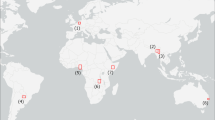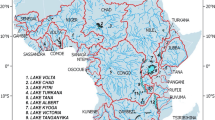Abstract
Coastal depth is an important research focus of coastal waters and is also a key factor in coastal environment. Dongluo Island in South China Sea was taken as a typical study area. The band ratio model was established by using measured points and three multispectral images of Landsat-8, SPOT-6 (Systeme Probatoire d’Observation de la Terre, No.6) and WorldView-2. The band ratio model with the highest accuracy is selected for the depth inversion respectively. The results show that the accuracy of SPOT-6 image is the highest in the inversion of coastal depth. Meanwhile, analyzing the error of inversion from different depth ranges, the accuracy of the inversion is lower in the range of 0–5 m because of the influence of human activities. The inversion accuracy of 5–10 m is the highest, and the inversion error increases with the increase of water depth in the range of 5–20 m for the three kinds of satellite images. There is no linear relationship between the accuracy of remote sensing water depth inversion and spatial resolution of remote sensing data, and it is affected by performance and parameters of sensor. It is necessary to strengthen the research of remote sensor in order to further improve the accuracy of inversion.
Similar content being viewed by others
References
Abileah R, 2013. Mapping near shore bathymetry using wave kinematics in a time series of WorldView–2 satellite images. Proceesings of 2013 IEEE International Geoscience and Remote Sensing Symposium (IGARSS). Melbourne, VIC: IEEE,2274–2277. doi: 10.1109/IGARSS.2013.6723271
Benny A H, Dawson G J, 1983. Satellite imagery as an aid to bathymetric charting in the Red Sea. The Cartographic Journal, 20(1): 5–16. doi: 10.1179/caj.1983.20.1.5
Bierwirth P N, Lee T J, Burne R V, 1993. Shallow sea–floor reflectance and water depth derived by unmixing multispectral imagery. Photogrammetric Engineering and Remote Sensing, 59(3): 331–338.
Clark R K, Fay T H, Walker C L, 1987. A comparison of models for remotely sensed bathymetry.MS, USA: Naval Ocean Research and Development Activity Stennis Space Center, AD–A197973.
Clarke G L, James H R, 1939. Laboratory analysis of the selective absorption of light by sea water. Journal of the Optical Society of America, 29(2): 43–55. doi: 10.1364/JOSA.29. 000043
Curcio J A, Petty C C, 1951. The near infrared absorption spectrum of liquid water. Journal of the Optical Society of America, 41(5): 302–304. doi: 10.1364/JOSA.41.000302
Di Kaichang, Ding Qian, Chen Wei et al., 1999. Shallow water depth extraction and chart production from TM images in Nansha Islands and nearby sea area. Remote Sensing for Land and Resources, 3: 59–64. (in Chinese)
Eugenio F, Marcello J, Martin J, 2015. High–resolution maps of bathymetry and benthic habitats in shallow–water environments using multispectral remote sensing imagery. IEEE Transactions on Geoscience and Remote Sensing, 53(7): 3539–3549. doi: 10.1109/TGRS.2014.2377300
Figueiredo I N, Pinto L, Gonçalves G, 2016. A modified Lyzenga’s model for multispectral bathymetry using Tikhonov regularization. IEEE Geoscience and Remote Sensing Letters, 13(1): 53–57. doi: 10.1109/LGRS.2015.2496401
Flener C, Lotsari E, Alho P et al., 2012. Comparison of empirical and theoretical remote sensing based bathymetry models in river environments. River Research and Applications, 28(1): 118–133. doi: 10.1002/rra.1441
Gitelson A, 1992. The peak near 700 nm on radiance spectra of algae and water: relationships of its magnitude and position with chlorophyll concentration. International Journal of Remote Sensing, 13(17): 3367–3373. doi: 10.1080/014311692 08904125
Gordon H R, 1979. Diffuse reflectance of the ocean: the theory of its augmentation by chlorophyll a fluorescence at 685 nm. Applied Optics, 18(8): 1161–1166. doi: 10.1364/AO.18.001161
Huang R Y, Yu K F, Wang Y H et al., 2017. Bathymetry of the coral reefs of Weizhou Island based on multispectral satellite images. Remote Sensing, 9(7): 750. doi: 10.3390/rs9070750
Jawak S D, Vadlamani S S, Luis A J, 2015. A synoptic review on deriving bathymetry information using remote sensing technologies: models, methods and comparisons. Advances in Remote Sensing, 4(2): 57480. doi: 10.4236/ars.2015.42013
Jay S, Guillaume M, Minghelli A et al., 2017. Hyperspectral remote sensing of shallow waters: considering environmental noise and bottom intra–class variability for modeling and inversion of water reflectance. Remote Sensing of Environment, 200: 352–367. doi: 10.1016/j.rse.2017.08.020
Johnson S Y, Cochrane G R, Golden N E et al., 2017. The California seafloor and coastal mapping program: providing science and geospatial data for California’s State waters. Ocean and Coastal Management, 140: 88–104. doi: 10.1016/j. ocecoaman. 2017.02.004
Lee Z, Hu C, Arnone R et al., 2012. Impact of sub–pixel variations on ocean color remote sensing products. Optics Express, 20(19): 20844–20854. doi: 10.1364/OE.20.020844
Li Jiabiao, 1999. Principles, Technology and Methods of Multibeam Survey. Beijing: China Ocean Press. (in Chinese)
Li J R, Zhang H G, Hou P F et al., 2016. Mapping the bathymetry of shallow coastal water using single–frame fine–resolution optical remote sensing imagery. Acta Oceanologica Sinica, 35(1): 60–66. doi: 10.1007/s13131–016–0797–x
Li Qingquan, Lu Yi, Hu Shuibo et al., 2016. Review of remotely sensed geo–environmental monitoring of coastal zones. Journal of Remote Sensing, 20(5): 1216–1229. (in Chinese)
Li Xian, Chen Shengbo, Wang Xuhui et al., 2008. Study based on radioactive transfer model of the quantitative remote sensing of water bottom reflectance. Journal of Jilin University (Earth Science Edition), 38(S1): 235–237. (in Chinese)
Lu Tianqi, Chen Shengbo, Guo Tiantian et al., 2016. Offshore bathymetry retrieval from SPOT–6 image. Journal of Marine Sciences, 34(3): 51–56. (in Chinese)
Lyzenga D R, 1978. Passive remote sensing techniques for mapping water depth and bottom features. Applied Optics, 17(3): 379–383. doi: 10.1364/AO.17.000379
Lyzenga D R, 1979. Shallow–water reflectance modeling with applications to remote sensing of the ocean floor. Proceedings of the 13th International Symposium on Remote Sensing of Environment. Ann Arbor, Michigan: Environmental Research Institute of Michigan, 583–602.
Lyzenga D R, 1981. Remote sensing of bottom reflectance and water attenuation parameters in shallow water using aircraft and Landsat data. International Journal of Remote Sensing, 2(1): 71–82. doi: 10.1080/01431168108948342
Manessa M D M, Kanno A, Sagawa T et al., 2018. Simulationbased investigation of the generality of Lyzenga’s multispectral bathymetry formula in Case–1 coral reef water. Estuarine, Coastal and Shelf Science, 200: 81–90. doi: 10.1016/j.ecss. 2017.10.014
Mgengel V, Spitzer R J, 1991. Application of remote sensing data to mapping of shallow sea–floor near by Netherlands. International Journal of Remote Sensing, 57(5): 473–479.
Odermatt D, Gitelson A, Brando V E et al., 2012. Review of constituent retrieval in optically deep and complex waters from satellite imagery. Remote Sensing of Environment, 118: 116–126. doi: 10.1016/j.rse.2011.11.013
Paredes J M, Spero R E, 1983. Water depth mapping from passive remote sensing data under a generalized ratio assumption. Applied Optics, 22(8): 1134–1135. doi: 10.1364/AO.22. 001134
Poupardin A, Idier D, de Michele M D et al., 2016. Water depth inversion from a single SPOT–5 dataset. IEEE Transactions on Geoscience and Remote Sensing, 54(4): 2329–2342, doi: 10.1109/TGRS.2015.2499379
Salama M S, Verhoef W, 2015. Two–stream remote sensing model for water quality mapping: 2SeaColor. Remote Sensing of Environment, 157: 111–122. doi: 10.1016/j.rse.2014.07.022
Sandidge J C, Holyer R J, 1998. Coastal bathymetry from hyperspectral observations of water radiance. Remote Sensing of Environment, 65(3): 341–352. doi: 10.1016/S0034–4257(98) 00043–1
Shu Xiaozhou, Yin Qiu, Kuang Dingbo, 2000. Relationship between algal chlorophyll concentration and spectral reflectance of inland water. Journal of Remote Sensing, 4(1): 41–45. (in Chinese)
Su H B, Liu H X, Heyman W D, 2008. Automated derivation of bathymetric information from multi–spectral satellite imagery using a non–linear inversion model. Marine Geodesy, 31(4): 281–298. doi: 10.1080/01490410802466652
Su H B, Liu H X, Wang L et al., 2014. Geographically adaptive inversion model for improving bathymetric retrieval from satellite multispectral imagery. IEEE Transactions on Geoscience and Remote Sensing, 52(1): 465–476. doi: 10.1109/TGRS. 2013.2241772
Su H B, Liu H X, Wu Q S, 2015. Prediction of water depth from multispectral satellite imagery—the regression Kriging alternative. IEEE Geoscience and Remote Sensing Letters, 12(12): 2511–2515. doi: 10.1109/LGRS.2015.2489678
Zhao Jianhu, Liu Jingnan, 2008. Multi–beam Sounding Technology and Image Data Processing. Wuhan: Wuhan University Press. (in Chinese)
Acknowledgment
We would like to thank Guangzhou Marine Geological Survey of China for its data support.
Author information
Authors and Affiliations
Corresponding author
Additional information
Foundation item: Under the auspices of the Program for Jilin University Science and Technology Innovative Research Team (No. JLUSTIRT, 2017TD-26), Plan for Changbai Mountain Scholars of Jilin Province, China
Rights and permissions
About this article
Cite this article
Lu, T., Chen, S., Tu, Y. et al. Comparative Study on Coastal Depth Inversion Based on Multi-source Remote Sensing Data. Chin. Geogr. Sci. 29, 192–201 (2019). https://doi.org/10.1007/s11769-018-1013-z
Received:
Accepted:
Published:
Issue Date:
DOI: https://doi.org/10.1007/s11769-018-1013-z




